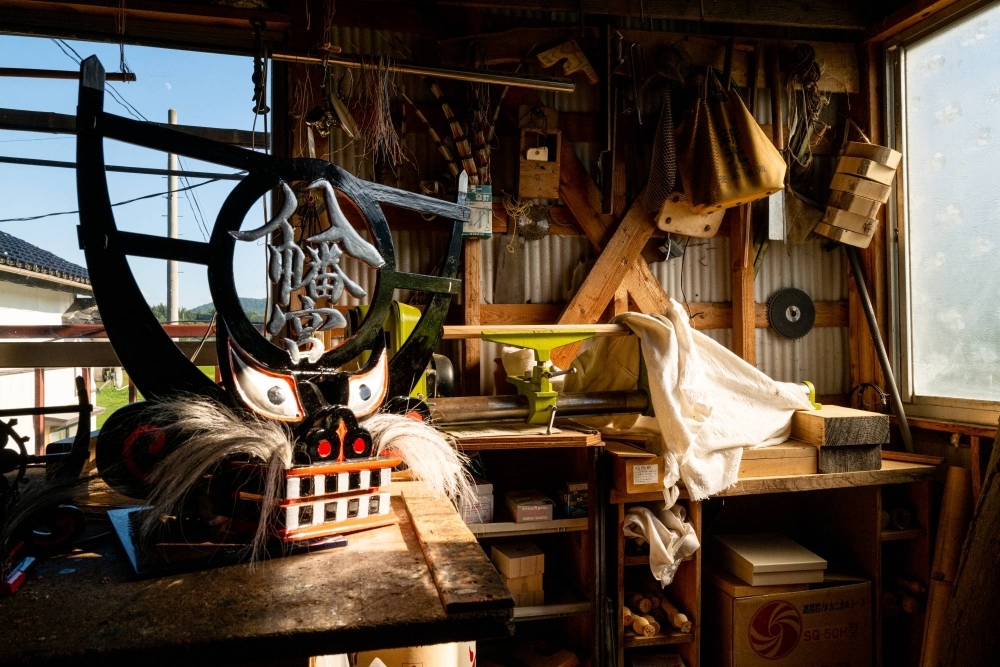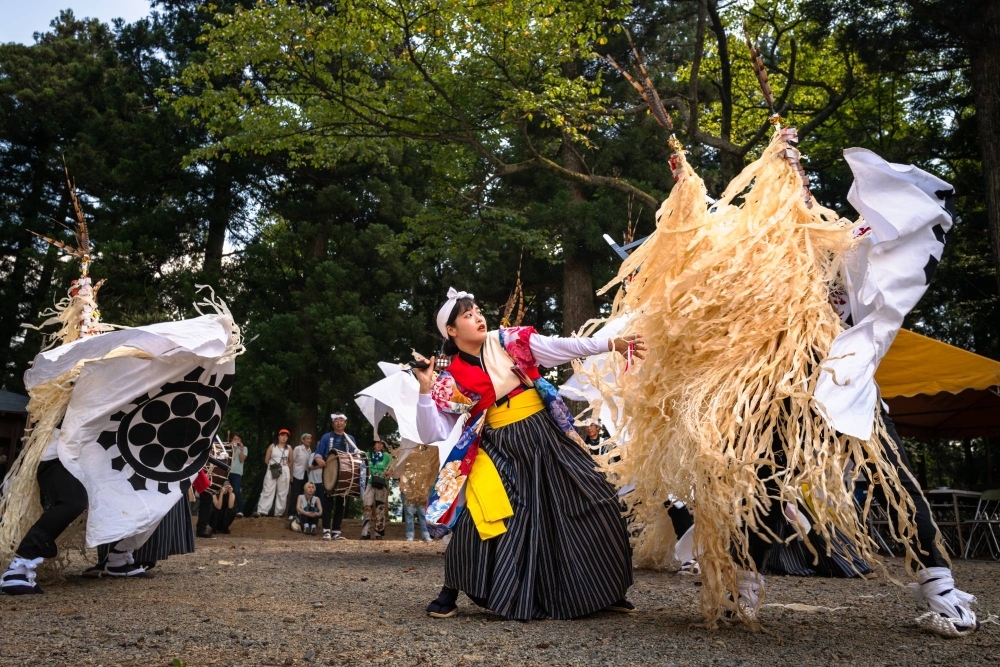On the outskirts of Tono, Iwate Prefecture, I gather with a group of travelers at the head of the short trail leading to a collection of statues known as the Gohyaku Rakan, (also known as the “Five-hundred Arhats”).
This spiritual work of art was created to honor the victims of the Great Tenmei famine in 1782. In an effort to pacify the restless spirits of the victims, a Buddhist priest from Daijiji temple carved reliefs of 500 rakan (Buddhist figures) statues from natural rocks in the area. Today, 380 remain, covered in patchy emerald moss on a steep hillside.
Crossing a small bridge, we follow the trail upward into the cool forest. There in a tranquil forest, our guide, Haruka Tada, shares stories of Tono’s long history of starvation and struggle. As she speaks, warm summer light filters through the darkness of the dense green trees, dappling the mossy stone faces of the rakan and large boulders at rest on the forest floor. Listening to these true stories of tragedies past in a fairy tale-like setting, the complicated origins of Tono’s reputation for dark folklore begin to emerge and make sense.
For those unfamiliar, Tono became known as the home of Japanese folk tales and yōkai (supernatural beings) culture after the region’s orally transmitted tales were collated as “Tono Monogatari” (The Legends of Tono), a collection of stories published by folklorist Kunio Yanagita in 1910. The collection would go on to become the Grimm’s fairy tales of Japan and cement Tono’s legacy as the setting of scary stories to tell in the dark. The local culture of the region, too, has a reputation for embracing a nebulous view of the space between life and death. Those eerie themes, both real and mythical, provide the backdrop and inspiration for the unique Tono Meguritoroge, a 3-year-old festival combining local history and the performing arts with modern culture and music to create an entirely new kind of event.
The name Meguritoroge (not the easiest for foreign tongues) comes from a local tradition called mukai toroge (welcoming lantern tree), in which a flag and lantern are erected to guide the spirits of ancestors back to their homes.
The festival is an attempt by a team of producers, documentarians, musicians and Tono locals to welcome new guests to the city by reinterpreting the shishi-odori (literally translated as “lion dance”) tradition and presenting Tono’s performing arts scene to a new generation.

A shishi-odori dancer prepares for the first performance of the day at Sugawara Shrine.
| LANCE HENDERSTEIN
Founder and producer Arina Tsukada describes how Tono Meguritoroge got its start with a 2020 documentary film project titled, “Dialogue with Anima.” “I met Gaku Tomikawa, a producer who had left his advertising career to move to Tono,” Tsukada says. “He had become inspired by the folktale culture and shishi-odori. Together we created a documentary with director Asato Sakamoto covering Tono’s unique perspective on life and death.
“Tono specializes in the performing arts. It also has a deep-seated belief in supernatural ‘invisible things,’ so I wanted to start a festival with invisible arts such as music.”
From Gohyaku Rakan, we drive a short distance to the nearby Tono Furusato Village, a traditional mountain village that hosts thatched-roof magariya houses from the later Edo Period (1603-1868) and the iconic Yamaguchi waterwheel for a quaint re-creation of the farming villages of old.
There, Tada shares another macabre piece of the region’s history — ubasute, a semi-mythologized form of senicide. To illustrate, Tada hands me a text and asks me to read it for the group on the site where these events are said to have occurred. In olden times, the text went, it was customary to send all people over 60 years of age to the rendaino (lotus platform field) to die. The old people didn’t want to die useless, so they would come down to the village to work the fields to get enough food to survive, which may be the origin of the Yamaguchi-area terms “haka-dachi” (standing in the grave), to describe going to the fields in the morning, and “haka-agari” (going up to the grave), for returning from the fields in the evening.
That evening, we gather at Takamuro Suikoen hall for a panel discussion on local mythology and a banquet dinner prepared by chef Kanako Ikeda, who blends the flavors of Southeast Asia with locally sourced ingredients to create an original fusion of tastes. Tomato Tobu, a local snack pub, curates the refreshments. Iwate is a hops-growing region with numerous craft beer brands like Tono Brewing and Zumona. It’s also known for a signature unrefined sake style called Dobekko. The drinks flow and the lights dim as Daiki Odagiri, 33, a performer specializing in kaidan (ghost stories) storytelling, takes the stage. Dressed in a dark kimono and sitting on a pillow in the style of a rakugo comedian, Odagiri shares modern stories told to him by local people, filled with mysterious figures and sashiki-warashi, imps and spirits who take the form of children to lurk in the doorways and closets of homes.

A freshly painted shishi-odori mask sits in the workshop where it was handmade, a process only a few artisans undertake today.
| LANCE HENDERSTEIN
“I’ve loved scary stories since I was little, and I started collecting ghost stories after moving to Tono,” Odagiri says of his passion for kaidan. “Currently, I’ve collected around 300 stories, and I am also transcribing them and publishing them.”
The next morning, we head to Sugawara Shrine for a local festival. In the parking lot, the shishi-odori dancers get into costume, lifting one another’s large masks onto their heads and adjusting the curtain-like mantles and paper streamers that enhance their violent movements with flair.
The narrow staircase leads us to a forest trail atop a hill where massive cedar trees loom over us all: young performers in colorful costumes, shishi-odori dancers, taiko drummers, guests and Shinto priests. As we wait, a costumed man walks around with a wooden lion puppet, biting the heads of people for good luck.
Finally, the music begins.
The drummers set the beat as shishi dancers enter the middle of the grounds in front of the humble shrine, thrashing, waving their curtain-like coverings and stomping on the ground in a furious melee of moves.
Joining the shishi are dancers dressed in colorful costumes and brandishing mock swords and folding fans. Together they perform a choreographed performance as wild as it is precise. In the past, the roles of the human heroes with swords and fans would have been played by men, but now it’s women who do battle with the ferocious beasts.
In the evening, we gather again for the grand finale at Rokko-shi, a forested mountain shrine with a long stone staircase. The performance at Sugawara Shrine had been a traditional one, but Rokko-shi promises to be something different.
The festival had enlisted electronic artists Daisuke Tanabe, Kuniyuki Takahashi (aka KOSS), and Yosi Horikawa to reimagine shishi-odori music and dancing into something contemporary, building on earlier editions of the festival that collaborated with musicians such as Kom_I of Wednesday Campanella fame and OLAibi.

The roles of the sword-wielding human heroes were once performed only by men, but women performers now do battle with shishi-odori beasts in dance form.
| LANCE HENDERSTEIN
“Following the Hariyama Shishi Odori (a local dance group) collaboration with Yosi Horikawa and Daisuke Tanabe, we asked Kuniyuki Takahashi to collaborate with Itazawa Shishi Odori (another dance troupe from Tono) for the first time,” explains director and producer Asato Sakamoto, 36. “The musicians went way beyond music theory and confronted primal aspects of the shishi-odori itself.”
As the sun begins to set in the sky over the fields of rice, guests wait outside the gates of Rokko-shi like they might at a popular nightclub in the city. The drums begin, quiet and distant at first, then louder as the dancers approach.
The first group is led by “Tanefukube” a man dressed as a hyottoko with the red headwrap and distinctly contorted face of the classic festival clown. Step by step, a line of child dancers follow, adorned in white headbands, red happi coats, billowing black-and-white striped skirts and pants, and sashes of red and yellow, a playful reminder that in addition to the cool factor of an electronic music festival, Tono Meguritoroge is, at its heart, a family-friendly affair involving locals at every step.
At the top of the ascent, the shrine grounds are filled with guests lined up in front of tents to try local food and drinks, or stake out places to sit on the stone stairs. The shrine is illuminated in shifting colors of orange, purple, red and blue. Even the massive trees are used as backgrounds for the spectacularly textured light show. Drummers take to the grounds and the shishi-odori dancers join them. They perform together first in the traditional shishi-odori style and rhythm.
The cotton candy sunset fades into a blue-hour twilight over the treeline, echoing the colors of the shrine’s illumination, and Tanabe and Horikwawa take the stage. Smoke from wood-burning pedestals creates a moody haze that accentuates the intense light show. The atmosphere is calm but electric in anticipation of the main performance.
When darkness falls, the shishi-odori dancers make final preparations near the woods away from the spectators who are busy dancing to the music of Tanabe and Horikawa.

Shishi-odori dancers take a rest between performances at Sugawara Shrine in Tono, Iwate Prefecture.
| LANCE HENDERSTEIN
What follows is a spectacle.
The finale is a blur of intense choreographed dancing synchronized with the music and lights — a truly unique collaboration between local artists and renowned electronic musicians, combining traditional and contemporary sensibilities in a spectacular location.
When it ends, Arina Tsukada takes the stage. Her voice hoarse, she expresses her gratitude to everyone involved at Meguritoroge. As she speaks, her emotions overwhelm her and she begins to weep tears of joy. Tsukada’s raw emotion spreads from the stage to the performers and into the audience of spectators — some shed tears while others smile and embrace.
In the afterglow, the line between performer and audience dissolves, like a spell has been broken and reality has returned. Masks are lifted to reveal the men hiding beneath the performing beasts. Children in attendance begin acting out the dances they witnessed, inspired, perhaps, to become shishi-odori dancers themselves someday. In their pantomime I see both the continuation of the past and the birth of something completely new.

